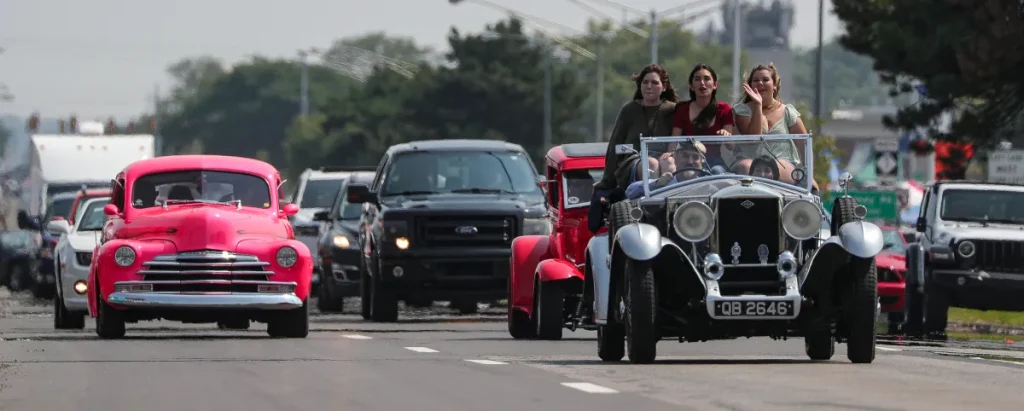 It begins, as it always does, with a sound. Not the cannon-crack of a dragster, but something subtler, more elemental: the low, syncopated murmur of a V8, felt as much in the rib cage as heard by the ear. On the Thursday before Dream Cruise weekend, it surfaces along Woodward Avenue like an old memory come to life. The engines idle at red lights in Ferndale, slip past the boutiques of Birmingham, hum over the rolling flats of Bloomfield Hills. They are apparitions in chrome and steel, longtail Buicks, shark-fin Chevrolets, candy-colored Mustangs, returning to the first paved mile in America for their yearly visitation.
It begins, as it always does, with a sound. Not the cannon-crack of a dragster, but something subtler, more elemental: the low, syncopated murmur of a V8, felt as much in the rib cage as heard by the ear. On the Thursday before Dream Cruise weekend, it surfaces along Woodward Avenue like an old memory come to life. The engines idle at red lights in Ferndale, slip past the boutiques of Birmingham, hum over the rolling flats of Bloomfield Hills. They are apparitions in chrome and steel, longtail Buicks, shark-fin Chevrolets, candy-colored Mustangs, returning to the first paved mile in America for their yearly visitation.
To call the Woodward Dream Cruise a car show is like calling a pilgrimage a stroll. It is, more truthfully, a living, rumbling archive of a time when Detroit didn’t just manufacture automobiles; it minted the American sense of itself. What began in 1995 as a neighborhood fundraiser has swollen into the world’s largest single-day automotive event, forty thousand classic cars, a million spectators, and traffic of biblical proportions. Yet its emotional coordinates are fixed in the nineteen-fifties and sixties, when Woodward was less a road than a proving ground. Teenagers in letterman jackets and pedal pushers moved in great, gleaming loops from Ted’s Drive-In back north, the circuit as hypnotic as it was infinite.
The cars provided the percussion: the sharp upshift of a four-speed, the low, rolling bass of dual exhausts. The melody, always, came from the radio. On Halloween night in 1963, a small AM station in Dearborn, WKNR, reemerged from obscurity as “Keener 13,” a transformation so swift and improbable it still circulates among broadcast historians with the air of myth: last place to first in ninety-one days.
Keener’s secret was velocity. While rivals lumbered through playlists and patter, Keener lived in the bloodstream of the moment. Thirty-one songs in rotation, no more, no less, meant the next hit was never far away. Personalities like Dick Purtan, Scott Regen and Bob Green, spoke with the rapid-fire intimacy of co-conspirators. They did not just introduce the music. They became a part of the experience. And in Detroit, that meant a front-row seat to Motown’s golden hour. On The Head Burger’s “Motown Mondays,” Scott Regen slid the latest 45s from the Supremes, the Temptations, the Four Tops directly into the hands of the kids steering GTOs and Fairlanes up and down Woodward. The city’s sound, equal parts factory grit and church-floor grace, seemed to be pouring out of the same foundry as the cars themselves.
To be seventeen, behind the wheel of a ’66 Mustang, Keener 13 broadcasting “Reach Out I’ll Be There” from the tinny dashboard speaker, was to occupy the exact center of the American map.
The present-day Cruise is at once altered and familiar. The drive-ins have given way to bistros; the audience spans three generations, grandparents pointing out their past lives in the form of parked Camaros to grandchildren who record them for TikTok. But, like the aura of Keener 13, the ritual survives. Folding chairs line the median, a grandstand for a parade whose pace is measured in heartbeats, not miles per hour. The air smells of gasoline and grilled meat, and the light, late-summer and forgiving, makes even the asphalt look nostalgic.
If you listen closely, past the chatter and the occasional protest of a mistimed clutch, you can still catch it: Classic Motor City Iron, lovingly restored, at rest at a red light, from which spills the bright, unmistakable burst of a PAMS jingle, “WKNR, Keener 13!”, Six decades later, still The Soundtrack of Detroit.

